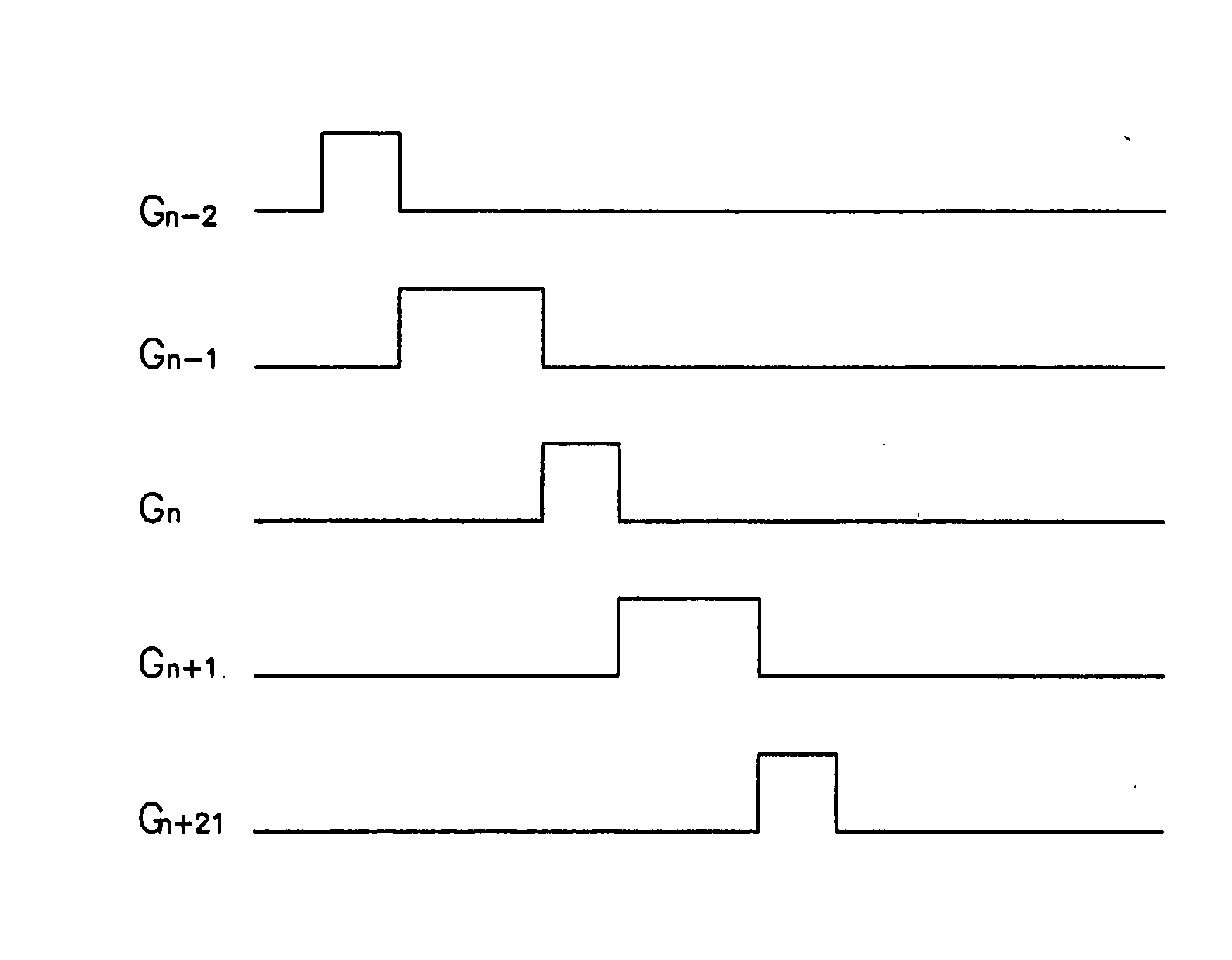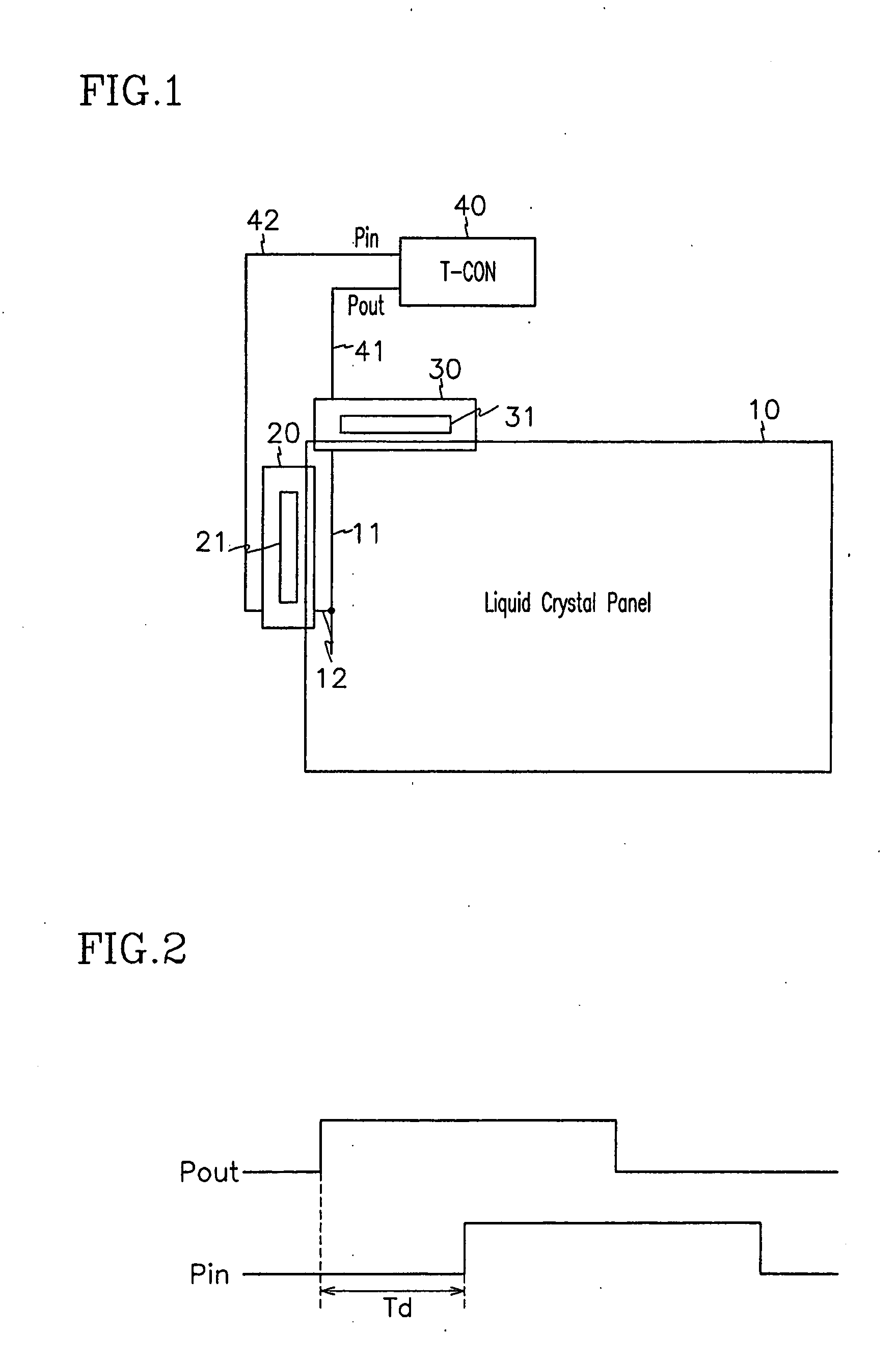Liquid crystal display and driving method thereof
a technology of liquid crystal display and driving method, which is applied in the direction of static indicating devices, non-linear optics, instruments, etc., can solve the problems of poor image quality and insufficient charge of the pixel supplied with a data signal having reversed polarity
- Summary
- Abstract
- Description
- Claims
- Application Information
AI Technical Summary
Benefits of technology
Problems solved by technology
Method used
Image
Examples
first embodiment
[0030] First, an LCD according to the present invention will be described with reference to FIGS. 1 and 3.
[0031]FIG. 1 is a schematic layout diagram of an LCD according to the first embodiment of the present invention. FIG. 2 is a diagram showing waveforms of pulses used for measuring load of a data line according to the first embodiment of the present invention, and FIG. 3 is a diagram showing waveforms of gate signals having pulse widths adjusted according to the first embodiment of the present invention.
[0032] Referring to FIG. 1, an LCD according to the first embodiment of the present invention includes a liquid crystal panel 10, gate and data tape carrier packages (“TCPs”) 20 and 30 connected to upper and left ends of the liquid crystal panel 10, respectively, and a timing controller (“T-CON”) 40 connected to the TCPs 20 and 30 via respective lid lines (not shown).
[0033] A plurality of gate lines (not shown) transmitting scanning signals or gate signals extending in a transve...
second embodiment
[0044] First, a second embodiment, which drives an LCD in one-dot inversion with high frequency and changes the inversion type into two-dot inversion upon the generation of flicker, is described with reference to FIG. 4.
[0045]FIG. 4 is a flowchart illustrating a driving method of an LCD according to the second embodiment of the present invention.
[0046] The second embodiment of the present invention uses one-dot inversion for an LCD driven with a frequency equal to or higher than 60 Hz such as 75 Hz. If the LCD is driven with a frequency higher than 60 Hz, flicker can be generated as shown in FIG. 7. In case that the flicker is generated, the conversion of the inversion type of the LCD into two-dot inversion avoids the deterioration of the image quality.
[0047] Now, it will be described in detail. As shown in FIG. 4, the timing controller 40 of the LCD according to the second embodiment of the present invention groups the entire pixels in the liquid crystal panel 10 into N blocks of...
third embodiment
[0054]FIG. 5 is a flowchart illustrating a driving method of an LCD according to the present invention.
[0055] The third embodiment of the present invention drives the LCD in two-dot inversion for 60 Hz frequency while in one-dot inversion for higher frequency such as 75 Hz. Since an LCD is usually driven with 60 Hz frequency, two-dot inversion driving of the LCD with 60 Hz frequency reduces power consumption. If the flicker is generated for the frequencies higher than 60 Hz, then the inversion type is changed into two-dot inversion to avoid the deterioration of the display quality as in the second embodiment of the present invention.
[0056] Now, it will be described in more detail. As shown in FIG. 5, the timing controller 40 of an LCD according to the third embodiment of the present invention determines whether the vertical driving frequency of the LCD is changed (S501). The determination of the frequency change is based on an internal clock of the timing controller 40 or an extern...
PUM
| Property | Measurement | Unit |
|---|---|---|
| vertical frequency | aaaaa | aaaaa |
| frequency | aaaaa | aaaaa |
| frequency | aaaaa | aaaaa |
Abstract
Description
Claims
Application Information
 Login to View More
Login to View More - R&D
- Intellectual Property
- Life Sciences
- Materials
- Tech Scout
- Unparalleled Data Quality
- Higher Quality Content
- 60% Fewer Hallucinations
Browse by: Latest US Patents, China's latest patents, Technical Efficacy Thesaurus, Application Domain, Technology Topic, Popular Technical Reports.
© 2025 PatSnap. All rights reserved.Legal|Privacy policy|Modern Slavery Act Transparency Statement|Sitemap|About US| Contact US: help@patsnap.com



